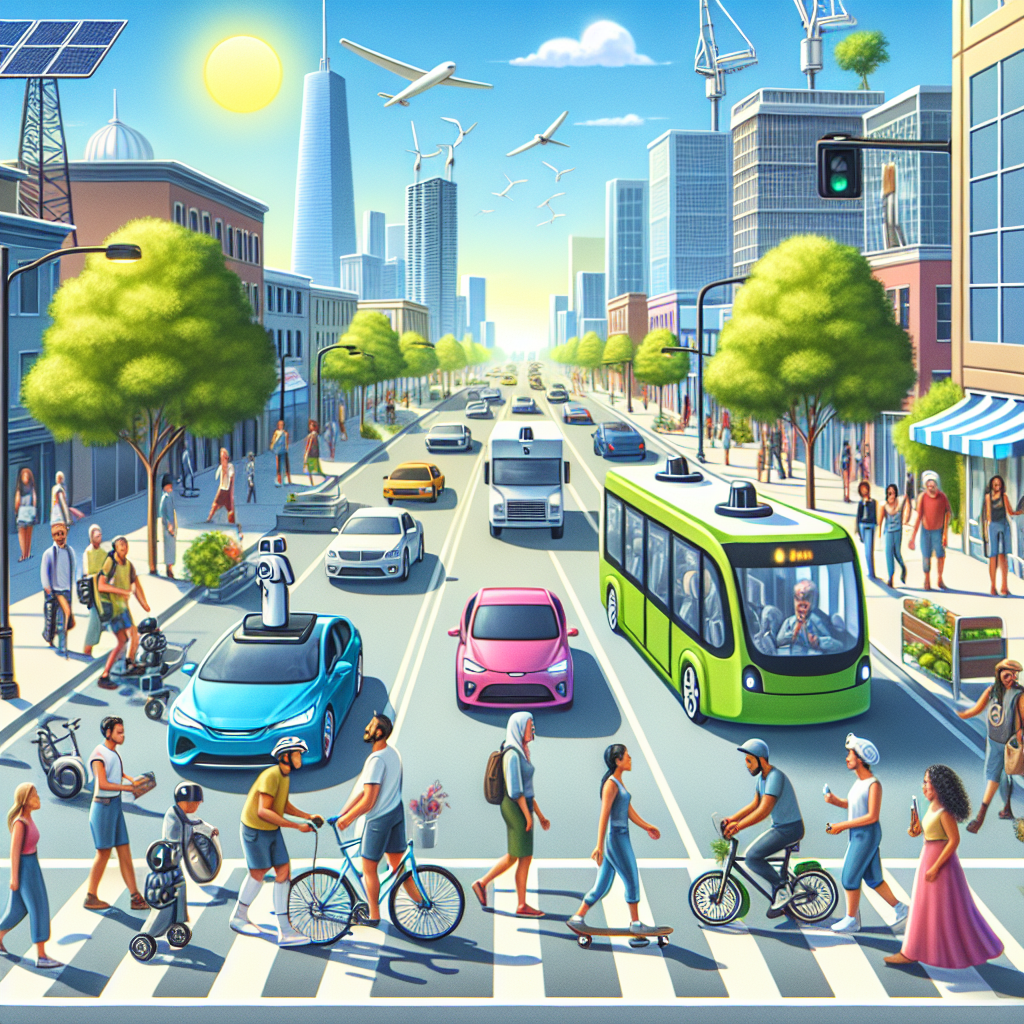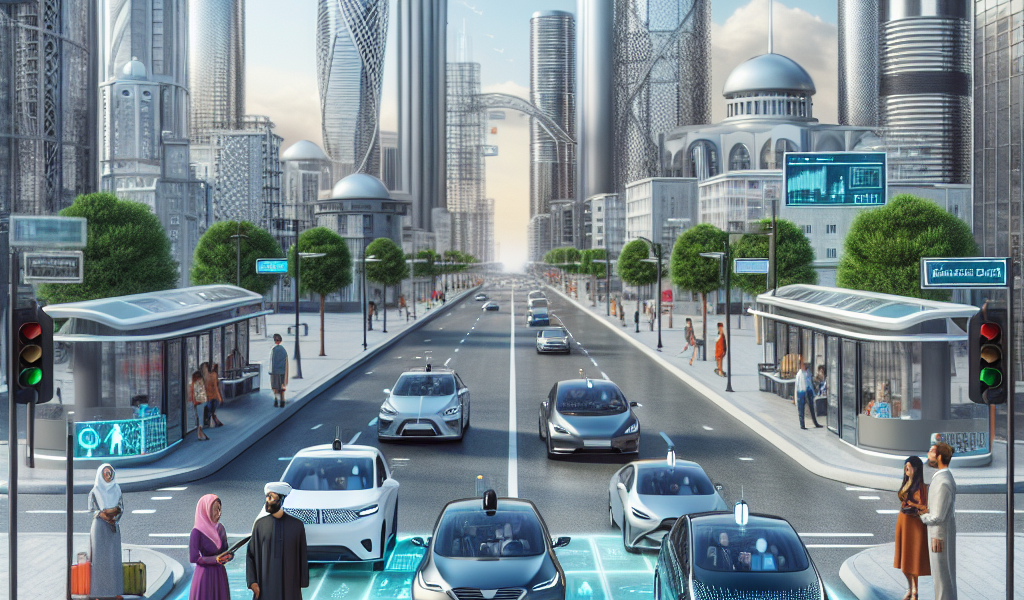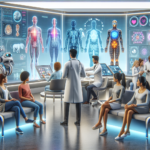-
Table of Contents
“Driving Tomorrow: The Autonomous Revolution”
Introduction

The future of autonomous vehicles promises to revolutionize transportation, reshaping urban landscapes, and transforming the way people and goods move. As advancements in artificial intelligence, sensor technology, and machine learning continue to accelerate, self-driving cars are becoming increasingly sophisticated and reliable. These vehicles are expected to enhance road safety by reducing human error, improve traffic efficiency, and provide greater mobility for individuals with disabilities or those unable to drive. Moreover, the integration of autonomous vehicles with smart city infrastructure could lead to more sustainable and efficient urban environments. However, this future also presents challenges, including regulatory hurdles, cybersecurity concerns, and the need for significant changes in public policy and infrastructure. As society navigates these complexities, the development and deployment of autonomous vehicles will likely play a pivotal role in shaping the transportation systems of tomorrow.
The Impact of Autonomous Vehicles on Urban Planning
The advent of autonomous vehicles is poised to revolutionize urban planning in ways that were once the stuff of science fiction. As self-driving cars become more prevalent, cities around the world are beginning to rethink their infrastructure, transportation systems, and even the very layout of urban spaces. This transformation promises to bring about significant changes, both positive and challenging, that will reshape the way we live, work, and move through our cities.
One of the most immediate impacts of autonomous vehicles on urban planning is the potential reduction in the need for parking spaces. Currently, a significant portion of urban land is dedicated to parking lots and garages, which often sit empty for large parts of the day. With self-driving cars, the necessity for such extensive parking infrastructure could diminish dramatically. These vehicles can drop passengers off at their destinations and then either park themselves in more remote locations or continue to serve other passengers. This shift could free up vast amounts of space in city centers, allowing for the development of green spaces, pedestrian zones, and new housing projects.
Moreover, the integration of autonomous vehicles into public transportation systems could lead to more efficient and flexible transit options. Self-driving buses and shuttles can operate on demand, adjusting their routes and schedules based on real-time data and passenger needs. This adaptability could make public transportation more appealing and accessible, reducing the reliance on private car ownership. Consequently, fewer cars on the road would lead to decreased traffic congestion and lower emissions, contributing to a cleaner and more sustainable urban environment.
However, the transition to a cityscape dominated by autonomous vehicles is not without its challenges. One significant concern is the potential displacement of jobs in the transportation sector. Taxi drivers, truckers, and delivery personnel may find their roles increasingly automated, leading to economic and social repercussions. Urban planners and policymakers will need to address these issues by creating new employment opportunities and providing support for workers transitioning to different industries.
Additionally, the widespread adoption of autonomous vehicles raises questions about data privacy and security. These vehicles rely on vast amounts of data to navigate and make decisions, which could be vulnerable to hacking or misuse. Ensuring robust cybersecurity measures and establishing clear regulations will be crucial to maintaining public trust and safety.
Despite these challenges, the potential benefits of autonomous vehicles for urban planning are immense. For instance, the reduction in traffic accidents, which are often caused by human error, could save countless lives and reduce the burden on emergency services and healthcare systems. Furthermore, the increased mobility offered by self-driving cars could enhance the quality of life for individuals who are unable to drive, such as the elderly and disabled, providing them with greater independence and access to essential services.
As cities begin to adapt to the presence of autonomous vehicles, collaboration between technology developers, urban planners, and policymakers will be essential. By working together, they can create a cohesive vision for the future that maximizes the benefits of this technology while addressing its potential drawbacks. The transformation of urban spaces in response to autonomous vehicles is an opportunity to build more sustainable, inclusive, and efficient cities that better serve the needs of all residents.
In conclusion, the impact of autonomous vehicles on urban planning is profound and multifaceted. While there are challenges to overcome, the potential for positive change is significant. By thoughtfully integrating this technology into our cities, we can create urban environments that are safer, more sustainable, and more equitable for everyone.
Ethical Considerations in Autonomous Vehicle Technology
As the dawn of autonomous vehicle technology approaches, society stands on the precipice of a transportation revolution. The promise of self-driving cars is tantalizing: reduced traffic accidents, increased mobility for the elderly and disabled, and the potential for more efficient urban planning. However, as we edge closer to this new era, it is imperative to address the ethical considerations that accompany the deployment of autonomous vehicles. These considerations are not merely technical challenges but moral quandaries that demand thoughtful deliberation.
One of the most pressing ethical issues is the decision-making process of autonomous vehicles in life-and-death situations. Unlike human drivers, who react instinctively in emergencies, autonomous vehicles must be programmed to make split-second decisions. This raises the question: how should these vehicles prioritize lives in unavoidable accidents? For instance, if an autonomous car must choose between hitting a pedestrian or swerving into oncoming traffic, the algorithms guiding these decisions must be scrutinized. The ethical frameworks embedded in these algorithms will reflect societal values, but whose values will they represent? This dilemma underscores the need for a transparent and inclusive dialogue involving ethicists, technologists, policymakers, and the public.
Moreover, the issue of accountability in the event of an accident involving an autonomous vehicle is another ethical conundrum. Traditional car accidents typically involve human error, and responsibility can be assigned to the driver. However, with autonomous vehicles, the lines of accountability blur. If a self-driving car causes an accident, who is to blame? Is it the manufacturer, the software developer, or the owner of the vehicle? Establishing clear guidelines for liability is crucial to ensure justice and maintain public trust in this emerging technology.
Privacy concerns also loom large in the ethical landscape of autonomous vehicles. These cars rely on a plethora of sensors and data collection mechanisms to navigate and make decisions. While this data is essential for the functionality of autonomous vehicles, it also raises significant privacy issues. Who owns the data collected by these vehicles, and how will it be used? There is a risk that this data could be exploited for commercial purposes or fall into the wrong hands, leading to potential breaches of privacy. Ensuring robust data protection measures and clear regulations on data usage is vital to safeguard individual privacy.
Furthermore, the advent of autonomous vehicles has profound implications for employment. The transportation sector employs millions of people worldwide, from truck drivers to taxi operators. The widespread adoption of self-driving technology could lead to significant job displacement, exacerbating economic inequality. Addressing this issue requires proactive measures, such as retraining programs and social safety nets, to support those affected by this technological shift.
In addition to these concerns, the environmental impact of autonomous vehicles cannot be overlooked. While these vehicles have the potential to reduce emissions through optimized driving patterns and the integration of electric powertrains, the production and disposal of autonomous vehicle components could have adverse environmental effects. Balancing the environmental benefits with the potential drawbacks is essential to ensure that the transition to autonomous vehicles contributes positively to sustainability goals.
As we navigate the ethical landscape of autonomous vehicle technology, it is clear that these considerations are complex and multifaceted. The journey towards a future with self-driving cars must be guided by a commitment to ethical principles, ensuring that the benefits of this technology are realized while minimizing potential harms. By fostering an inclusive and transparent dialogue, society can steer the development of autonomous vehicles in a direction that aligns with our collective values and aspirations.
The Role of AI in Enhancing Autonomous Vehicle Safety
The future of autonomous vehicles is a topic that has captured the imagination of technologists, policymakers, and the general public alike. Central to this vision is the role of artificial intelligence (AI) in enhancing the safety of these self-driving cars. As we stand on the brink of a transportation revolution, it is crucial to understand how AI is being harnessed to make autonomous vehicles not only a reality but also a safe and reliable mode of transport.
AI’s involvement in autonomous vehicle safety begins with its ability to process vast amounts of data in real-time. Unlike human drivers, who can be distracted or fatigued, AI systems are designed to remain vigilant at all times. These systems use a combination of sensors, cameras, and radar to gather information about the vehicle’s surroundings. This data is then analyzed using complex algorithms to make split-second decisions. For instance, if a pedestrian suddenly steps onto the road, the AI can quickly calculate the best course of action to avoid a collision, something that might take a human driver precious seconds to react to.
Moreover, AI’s predictive capabilities are another significant advantage. By analyzing patterns in traffic flow, weather conditions, and even the behavior of other drivers, AI can anticipate potential hazards before they become imminent threats. This predictive power is particularly useful in urban environments, where the density of vehicles and pedestrians can create a chaotic and unpredictable landscape. By foreseeing potential dangers, AI can take preemptive measures to mitigate risks, thereby enhancing overall safety.
Transitioning from the theoretical to the practical, it is essential to consider the real-world applications of AI in autonomous vehicles. Companies like Tesla, Waymo, and Uber are already integrating advanced AI systems into their fleets. These systems are continually learning and improving through machine learning algorithms. Each mile driven provides new data that helps refine the AI’s decision-making processes. This continuous learning loop ensures that the technology becomes safer and more reliable over time.
However, the journey towards fully autonomous vehicles is not without its challenges. One of the most significant hurdles is ensuring that AI systems can handle the myriad of unpredictable scenarios that can occur on the road. While AI excels in controlled environments, the real world is far more complex. Unexpected events, such as a child chasing a ball into the street or a sudden road closure, require the AI to adapt quickly and effectively. To address this, developers are employing advanced simulation techniques to expose AI systems to a wide range of scenarios, thereby improving their robustness and adaptability.
In addition to technical challenges, there are also ethical considerations. The decisions made by AI in critical situations can have life-or-death consequences. For example, if an accident is unavoidable, how should the AI prioritize the safety of the vehicle’s occupants versus pedestrians? These ethical dilemmas are the subject of ongoing debate and research, highlighting the need for a collaborative approach involving technologists, ethicists, and policymakers.
As we look to the future, it is clear that AI will play a pivotal role in the development of autonomous vehicles. By enhancing safety through real-time data processing, predictive analytics, and continuous learning, AI has the potential to transform our roads into safer spaces. However, achieving this vision will require overcoming significant technical and ethical challenges. With continued innovation and collaboration, the dream of safe, autonomous vehicles is within reach, promising a future where transportation is not only more efficient but also significantly safer for everyone.
Conclusion
The future of autonomous vehicles holds significant promise, with potential to revolutionize transportation by enhancing safety, reducing traffic congestion, and lowering emissions. Advances in artificial intelligence, sensor technology, and connectivity are driving rapid progress, making fully autonomous vehicles increasingly viable. However, challenges such as regulatory hurdles, cybersecurity concerns, and public acceptance must be addressed. As these issues are resolved, autonomous vehicles are expected to become a transformative force in both personal and commercial transportation, leading to more efficient, sustainable, and accessible mobility solutions.





